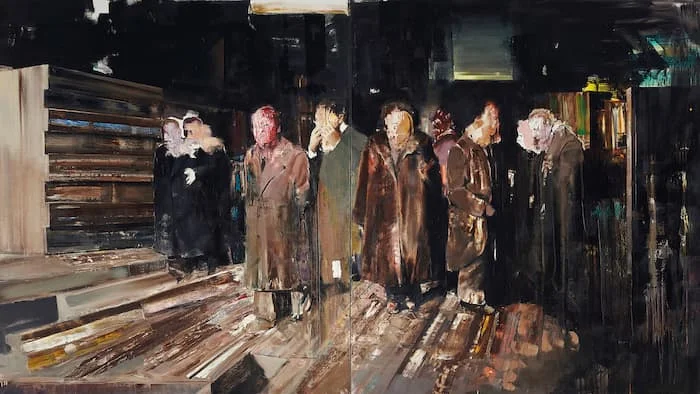The Art Market: uncertainty in New York, sales in Turin
How will this week’s New York auctions react to political events?
‘Nickelodeon’ (2008) by Adrian Ghenie, sold at Christie’s by François Pinault
NOVEMBER 11, 2016
by: Melanie Gerlis
Political uncertainty has turned to fear as the US presidential election concluded with a victory to Donald Trump. While low on the list of the world’s problems, the art market will not be immune. Optimists will take comfort in the rush to buy gold and align paintings with safe haven investments. But art is not an easily tradable commodity and its market of unique goods is more akin to high-end luxury, for which demand is a byproduct of confidence, and the money in people’s pockets. Financial markets in Asia and Europe were falling as this column went to press, with predictions of continued global sell-offs. Not the ideal backdrop for the bellwether New York auctions — with more than $1bn of art on the block — this week.
Some people will always be winners, however. The lucky seller of that Adrian Ghenie painting at Christie’s in London last month was François Pinault, who owns the auction house through Groupe Artémis. The work — “Nickelodeon” (2008), guaranteed by a third party — soared ahead of its £1m to £1.5m estimate on October 6 to sell for a record £6.2m (£7.1m with fees). The work was priced in five figures when it originally sold to Pinault in 2008-9, through Haunch of Venison gallery, which Christie’s owned at the time.
Ghenie’s works began appearing at auction in 2011, the year his work was included in an exhibition at the Palazzo Grassi in Venice, the museum that houses Pinault’s private collection (“Nickelodeon” was not included in this show).
Christie’s says it doesn’t comment on any of its clients’ transactions.
Turin’s heavily curated, elegant Artissima fair for 193 contemporary and Modern art galleries (November 4-6) has a reputation for being a place at which to show, but not sell. Director Sarah Cosulich says this is too much of a generalisation. “It may not be a fair at which after two hours everything has sold out, but our gallery return rate is high, so there is clearly still a reason to come back.”
One reason is the space and prominence given to smaller galleries, and their lesser-known artists, that are often at the periphery of similar-sized fairs. “It’s a rare fair in that you can still discover artists and galleries,” says the Madrid dealer Sabrina Amrani, who brought a striking solo booth of sculptures by the Canadian artist Babak Golkar. She sold “Inherited Revolution” (€16,000), a melting suitcase from Golkar’s “Time Capsules” series, dated 2016-2116 (the works are meant to hold their form and value for 100 years). Golkar’s other works proved Instagram hits at least.
‘The Fox, the Nut and the Banker’s Hand’ (2016-2116) by Babak Golkar © Courtesy the artist and Sabrina Amrani
Other sales included twin photograph and text works (2015) by Dénes Farkas (€1,500 for a pair, Ani Molnár gallery) and “Takbir” (2016), a shimmering tapestry by the quietly activist Cape Town artist Igshaan Adams (€10,000, Blank Gallery).
Sales were also made for affordable, rediscovered artists from the 20th century. The London dealer Richard Saltoun sold pieces by the Austrian artist Greta Schödl (up to €10,000), while Turin and London’s Mazzoleni sold pieces by Paolo Cotani and Gianfranco Zappettini (up to €50,000).
Also in Turin last week was the board of the Philadelphia Museum of Art, which has formed a new collaboration with the city’s influential collector, patron and private museum owner, Patrizia Sandretto Re Rebaudengo. They are to offer financial and curatorial support to commission and buy ambitious video works. The New York artist Rachel Rose is the first to receive the two-yearly commission, which will culminate in shows at the Philadelphia museum in April 2018 and then the Fondazione Sandretto Re Rebaudengo in the Autumn. The commissioned works will be jointly owned by both collections.
The project is targeted at artists who are at a “turning point” in their careers, Sandretto Re Rebaudengo says. “The market alone cannot offer this possibility.” Timothy Rub, the director of the Philadelphia museum, says “Foundations like Patrizia’s have the resources and connections that we can benefit from.” He expects to see more institutions team up with private museums in the future.
Moves by senior auction house and gallery experts to open their own boutique businesses have parallels in the banking industry, where big name dealmakers from companies such as Goldman Sachs and Morgan Stanley have created niche firms that say they offer more discreet, unfettered advice.
Officially in business now are Sotheby’s alumni Melanie Clore and Henry Wyndham. Their art advisory firm, Clore Wyndham, will work on broking high-quality works in the Old Masters to classic contemporary fields, as well as taking on retained clients and offering advice. “It won’t be about having shows or doing art fairs, this is about objectivity, discretion and relationships,” Clore says.Sotheby’s chief executive, Tad Smith, offered some limited green shoots as the company announced an expected fall in its results for the third quarter and nine months of 2016 on November 7. The third quarter is historically weak for Sotheby’s as it includes the quiet summer months. This time around the third-quarter loss grew from $17.9m in 2015 to $54.5m and profits fell from $54.9m for the first nine months of the year in 2015 to $8.6m this time, largely reflecting the fall in the volume of auction sales.
On the plus side, Smith says that the level of unsold lots has improved from 23 per cent in the third quarter of last year to 19 per cent this year, commission margins are up and the decline in net auction sales is improving.
Photograph: Oak Taylor-Smith
Copyright The Financial Times Limited 2016. All rights reserved. You may share using our article tools. Please don't cut articles from FT.com and redistribute by email or post to the web.


